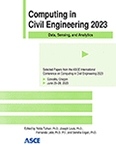Potential Safety Challenges of Four-Legged Robots in Construction
Publication: Computing in Civil Engineering 2023
ABSTRACT
In recent years, the construction industry has increasingly adopted the use of four-legged robots. These robots offer several advantages, including time-saving, improved accessibility to dangerous or inaccessible areas, and cost reduction. However, integrating these robots into the workplace introduces new hazards. Unfortunately, no research has been conducted to assess the risks associated with four-legged robots in construction. To have a comprehensive understanding of the four-legged robot integration in construction workplaces, it is crucial to consider their impact on health and safety. To this end, a study was conducted using virtual reality (VR) visualization techniques to simulate conceptual scenarios that required human interaction with four-legged robots at proximal and distant distances. Few construction safety experts observed these scenarios and ranked the potential safety challenges of four-legged robots. The study provides valuable insight into the potential safety challenges posed by four-legged robots and can assist in ensuring their safe integration on construction sites.
Get full access to this article
View all available purchase options and get full access to this chapter.
REFERENCES
Afsari, K., Halder, S., Ensafi, M., DeVito, S., and Serdakowski, J. (2021). Fundamentals and Prospects of Four-Legged Robot Application in Construction Progress Monitoring. EPiC Series in Built Environment, 2, 274–263. https://doi.org/10.29007/cdpd.
Arntz, M., Gregory, T., and Zierahn, U. (2017). Revisiting the risk of automation. Economics Letters, 159, 157–160. https://doi.org/10.1016/J.ECONLET.2017.07.001.
Bellicoso, C. D., Bjelonic, M., Wellhausen, L., Holtmann, K., Günther, F., Tranzatto, M., Fankhauser, P., and Hutter, M. (2018). Advances in real-world applications for legged robots. Journal of Field Robotics, 35(8), 1311–1326. https://doi.org/10.1002/rob.21839.
Bureau of Labor Statistics. (2019). Fatal Injury Report. https://www.bls.gov/iif/oshwc/cfoi/cftb0324.htm.
Bureau of Labor Statistics. (2022). National Census of Fatal Occuptational Injuries in 2021. https://www.bls.gov/news.release/pdf/cfoi.pdf.
Cong, Z., Honglei, A., Wu, C., Lang, L., Wei, Q., and Hongxu, M. (2020). Contact Force Estimation Method of Legged-Robot and Its Application in Impedance Control. IEEE Access, 8, 161175–161187. https://doi.org/10.1109/ACCESS.2020.3021080.
Gheisari, M., and Esmaeili, B. (2019). Applications and requirements of unmanned aerial systems (UASs) for construction safety. Safety Science, 118, 230–240. https://doi.org/10.1016/j.ssci.2019.05.015.
Halder, S., and Afsari, K. (2022). Real-time Construction Inspection in an Immersive Environment with an Inspector Assistant Robot. ASC 2022 (EPiC Series in Built Environment), 406–414.
Halder, S., Afsari, K., Serdakowski, J., and Devito, S. (2021). A Methodology for BIM-enabled Automated Reality Capture in Construction Inspection with Quadruped Robots. 38th International Symposium on Automation and Robotics in Construction (ISARC 2021).
Hall, E. T. (1969). The Hidden Dimension.
Haslam, R. A., Hide, S. A., Gibb, A. G. F., Gyi, D. E., Pavitt, T., Atkinson, S., and Duff, A. R. (2005). Contributing factors in construction accidents. Applied Ergonomics, 36(4), 401–415. https://doi.org/10.1016/J.APERGO.2004.12.002.
Jang, Y., Seol, W., Lee, K., Kim, K.-S., and Kim, S. (2022). Development of quadruped robot for inspection of underground pipelines in nuclear power plants. Electronics Letters, 58(06). https://doi.org/10.1049/ell2.12414.
Jeelani, I., and Gheisari, M. (2022). Safety Challenges of Human-Drone Interactions on Construction Jobsites. In H. Jebelli, M. Habibnezhad, S. Shayesteh, S. Asadi, & S. Lee (Eds.), Automation and Robotics in the Architecture, Engineering, and Construction Industry (pp. 143–164). Springer Cham. https://doi.org/10.1007/978-3-030-77163-8_7.
Kim, I. S., Choi, Y., and Jeong, K. M. (2017). A new approach to quantify safety benefits of disaster robots. Nuclear Engineering and Technology, 49(7), 1414–1422. https://doi.org/10.1016/j.net.2017.06.008.
Le, Q. T., Pedro, A., and Park, C. S. (2015). A Social Virtual Reality Based Construction Safety Education System for Experiential Learning. Journal of Intelligent and Robotic Systems: Theory and Applications, 79(3–4), 487–506. https://doi.org/10.1007/s10846-014-0112-z.
NIOSH. (2019). National Institute for occupational health and safety (NIOSH) Strategic Plan: FYs 2019−2023. https://www.cdc.gov/niosh/about/strategicplan/.
Perrow, C. (1999). Normal, Accidents, Living with High Risk Technologies - Updated Edition. Princeton University Press.
Safeea, M., and Neto, P. (2019). Minimum distance calculation using laser scanner and IMUs for safe human-robot interaction. Robotics and Computer-Integrated Manufacturing, 58, 33–42. https://doi.org/10.1016/j.rcim.2019.01.008.
Statista Research Department. (2022, April 1). Value added to GDP by U.S. construction 2021. Statista. https://www.statista.com/statistics/785445/value-added-by-us-construction/.
Suraji, A., Duff, A. R., and Peckitt, S. J. (2001). Development of Causal Model of Construction Accident Causation. Journal of Construction Engineering and Management, 127(4), 337–344. https://doi.org/10.1061/(ASCE)0733-9364(2001)127:4(337).
Vasconez, J. P., Kantor, G. A., and Auat Cheein, F. A. (2019). Human–robot interaction in agriculture: A survey and current challenges. Biosystems Engineering, 179, 35–48. https://doi.org/10.1016/J.BIOSYSTEMSENG.2018.12.005.
Williams, S. O., Hamid, A. R., and Misnan, S. M. (2018). Accident Causal Factors on the Building Construction Sites: A Review. International Journal of Built Environment and Sustainability, 5(1), 78–92. https://doi.org/10.11113/ijbes.v5.n1.248.
Winge, S., Albrechtsen, E., and Mostue, B. A. (2019). Causal factors and connections in construction accidents. Safety Science, 112, 130–141. https://doi.org/10.1016/J.SSCI.2018.10.015.
Information & Authors
Information
Published In
History
Published online: Jan 25, 2024
ASCE Technical Topics:
- Automation and robotics
- Benefit cost ratios
- Business management
- Construction engineering
- Construction industry
- Construction management
- Construction sites
- Engineering fundamentals
- Financial management
- Occupational safety
- Personnel management
- Practice and Profession
- Public administration
- Public health and safety
- Safety
- Systems engineering
Authors
Metrics & Citations
Metrics
Citations
Download citation
If you have the appropriate software installed, you can download article citation data to the citation manager of your choice. Simply select your manager software from the list below and click Download.
